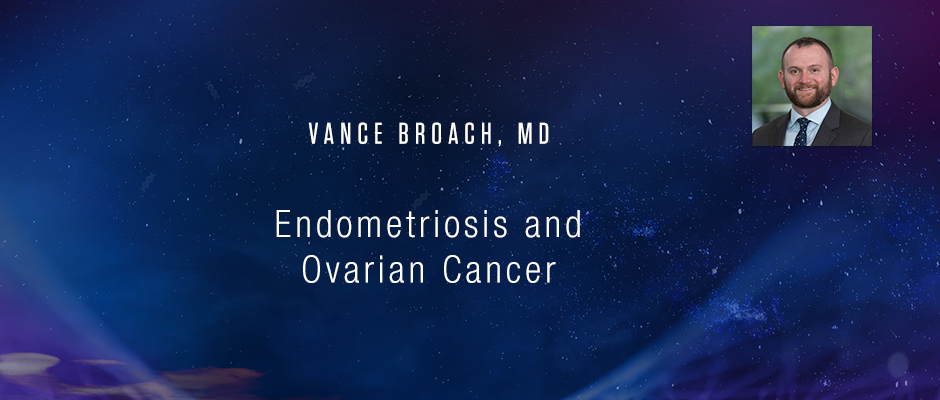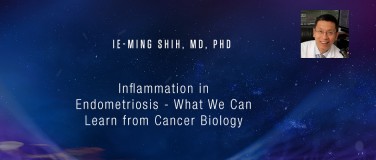Vance Broach, MD - Endometriosis and Ovarian Cancer
Endometriosis Foundation of America
Medical Conference 2019
Targeting Inflammation:
From Biomarkers to Precision Surgery
March 8-9, 2019 - Lenox Hill Hospital, NYC
https://www.endofound.org/medicalconference/2019
Well. Thank you very much. It's a real privilege and honor to be here. It's a particular privilege to share a podium with Dr. Chi who's a real luminary in the field and if you'll allow me to indulge my imposter syndrome for a moment, it's a privilege particularly being more junior in my career to sit and speak with really the leaders and pioneers in the treatment and understanding of endometriosis. It's a great, great privilege to be here and hopefully I can add some to our discussion. I don't have any thing to disclose for anybody who's read the news recently. I'm going to start by talking about two patients. Both of these patients have ovarian cancer, "ovarian cancer." I'm going to try to make it obvious that there are some differences between these two patients and something that we classify as the same disease.
First patient is a 67-year old. She presents with bloating, constipation, early satiety, gets a CT, demonstrates bilateral ovarian masses and peritoneal carcinomatosis. Her treatment includes an open surgery that involves removal of her pelvic organs, and a debulking of upper abdominal disease for what we would classify as an ovarian cancer. Afterwards, she receives chemotherapy, six cycles of carboplatin and paclitaxel. Another patient, this time of 47-year old who has a history of pelvic pain, painful menses and has an acute onset of pelvic pain that prompts her to present to the emergency room where an ultrasound demonstrates and eight centimeter right ovarian mass. She undergoes a laparoscopic removal of the ovary which demonstrates in ovarian cancer. Then she undergo surgical removal of the uterus, the other tube and ovary, along with some pelvic implants and omental implant, as well as dissection of her pelvic lymph nodes, paraaortic lymph nodes. She receives postoperative chemotherapy and this is followed by radiation therapy.
So clearly these two patients have some differences. One is a bit older, one is a bit younger. Their surgeries different, their postoperative treatment is different, but yet these both, both of these patients have what we would classify as stage three ovarian cancer. Clearly we're missing something. Right, so in this talk, what I'm going to do is hopefully outline what do we mean by ovarian cancer, what types of ovarian cancer associated with endometriosis, touch a little bit on the molecular and genetic causes of endometriosis and their associated ovarian cancers, talk a bit about the treatment of endometriosis associated ovarian cancers and touch a bit on how we might be able to prevent these in the first place.
So what do we mean by ovarian cancer? Well, there are a number of different types of ovarian cancer, cancer of the outside of the ovary, epithelial ovarian cancer or the fallopian tube as well as cancers of the stroma or the germ cells in the ovaries. But I'm going to focus on epithelial ovarian cancers. Even among that subdivision, there are a number of different types of ovarian cancer, high grade serious, low grade serious, mucinous, endometrioid, clear cell and and others. While there's a great deal of heterogeneity just among the presentation and pathology, the incidents of these varies as well. High grade serious is the most common type, whereas other types, clear cell and endometrioid and others represent a smaller proportion of patients with ovarian cancer.
Dr. Chi did a wonderful distillation of some of the pathologic features of ovarian cancers in his talk just a moment ago, but even amongst what we would classify as epithelial ovarian cancers, the cell of origin and how they appear under the microscope is very different. Clinically, they behave differently as well. High grade serious carcinoma almost always presents in advanced stages and where a small proportion presents at an early stage, whereas clear cell carcinoma, endometrioid carcinoma, mucinous present almost always at an early stage. Survival differs as well. High grade serious is associated with the lowest survival, probably owing to the advanced age at which patients normally present, whereas other histologies are associated with better survivals. What I'm trying to make is that these are not all the same disease and what we find is that those ovarian cancers associated with endometriosis or the endometrioid and clear cell types.
This is a table from an epidemiologic study by authors at UCLA Memorial and Duke, among others, that looked at what types of cancer associated with endometriosis and indeed, clear cell and endometrioid were most strongly associated with endometriosis. Where mucinous, high grade were much less associated or not associated at all. Low grade serious may be associated with endometriosis, but we don't really understand that as well. This is a very large table and I'm going to refer back to it a number of times, published in 2016 in JCO and right now I'm going to refer just to this line at the bottom. This looks at types of ovarian cancer here, serious, endometrioid, mucinous and clear cell and this is odds ratio of developing this and endometriosis is a risk factor for endometrioid and clear cell here as you can see. These are epidemiologic studies.
So knowing that these are different, epidemiologically, they're different types of cancers and that they present in different ways, I'm going to touch a bit on the genetic and molecular drivers of these types of cancers. P53 is a mutation that's almost ubiquitously associated with high grade serious carcinomas. Others, BRCA mutations and some moderate penetrance genes, RAD51 and others, are typically associated with high grade serious carcinomas. Whereas some of the mutations in genes that have been mentioned a number of times at this conference, ARID1a, PTEN, KRAS and others are associated with endometriosis associated ovarian cancers and endometriosis. This mutation in ARID1a for example is a president about 50% of endometriosis associated ovarian cancers and it's important because it's a potential target for treatment and a marker of prognosis.
So this is, I think, the complexity of the diagram is directly related to the complexity of somebody's brain. So this is, I'm a surgeon, so this is about what you get from me. Okay, two arrows and after that I get confused. So this is normal cells here, you see they're round, and these are cancer cells here, see they're not round. All right. So what I'm going to point out here is that both in the cell of origin, the mutations that drive cancers and in the tumor microenvironment are different amongst those patients with a high grade serious carcinoma versus those with endometrioid or clear cell carcinoma, which would tend to be associated with endometriosis. Cell of origin for a, this will be red for high grade serious and purple for endometriosis associated. Realized now I probably could have chosen colors that have a little bit different, they're a little bit different looking, but this will be on the bottom and this will be on the top.
So remember this is high grade serious carcinoma and this will be endometriosis. Almost always, high grade serious carcinoma start in the fallopian tube, probably about 70 to 80% and maybe more of high grade serious carcinomas start in the fallopian tube. Whereas the cell of origin for endometriosis associated ovarian cancers may be the fallopian tube, maybe the ovarian surface, maybe an ovarian inclusion cyst and maybe ectopic endometrium altogether, which is not involving the ovary at all. Ubiquitously, P53 mutations for high grade serious carcinoma, BRCA and others that I mentioned. Whereas the mutations for endometriosis associated ovarian cancer is ARID1a, PTEN and KRAS. The tumor microenvironment also probably plays a great role in the development of these cancers. The tumor microenvironment of the ovarian stroma is usually the growth spot for high grade serious carcinomas, whereas that might be the ovarian stroma or might be the pelvic peritoneum or other places for endometriosis associated ovarian cancers. Again, this would lead to high grade serious versus endometriosis associated.
So I'll move a little bit in just how we treat these types of cancers. I regret to tell you that the treatment for as much as we know about the differences between these types of cancers, we haven't come very far in differentiating appropriate treatments for these types of cancers. Surgery is the primary treatment in any patient who's eligible or otherwise healthy involves removing and staging the, removing the disease and performing a staging procedure, and really the goal of this procedure is to remove all the visible tumor or to check to be sure that cancer hasn't spread into any other places. The contralateral ovaries, if there's an ovarian implant, the uterus, pelvic and paraaortic lymph nodes and the peritoneum. The majority of these patients with disease outside of the ovary receive chemotherapy following surgery and that's typically carboplatin and paclitaxel.
People have looked at the role of radiation therapy as an adjunct to treating endometriosis associated ovarian cancer. This study by Hoskins published in JCO in 2012 looked at this specifically. This patient's got a regimen of three cycles of chemotherapy followed by a whole pelvic radiation therapy in patients who had clear cell carcinoma and those patients who received radiotherapy did seem to do a bit better than those patients who didn't. Now, one of the drawbacks of this study is probably the way that the radiation was given and be a little different from the way that we would give it typically, but still is interesting food for thought.
Moving into a bit of prevention for these types of cancers. These things are our strategies that we know help prevent both ovarian cancer at large as well as endometriosis associated ovarian cancer, specifically. Contraceptive pill use, pregnancy, early menopause, I grant you probably not a treatment strategy that we'd recommend to patients, but it's definitely associated with a reduced risk of these types of cancers, hysterectomy and tubal ligation or removal of the tube altogether. Referring back to this table from the article from JCO in 2016, you can see these are all listed here. This is hormone therapy use, age at menopause, breastfeeding, contraceptive use, and pregnancies or number of children. Specifically clear cell and endometrioid ovarian cancers really have benefits from a number of these things even by comparison to other types of ovarian cancer, specifically oral contraceptive use, pregnancies and down here tubal ligation and hysterectomy.
So to conclude, endometriosis associated ovarian cancers are distinct entities from other types of ovarian cancers and the treatments are not always the same. The genetic and molecular underpinnings of endometriosis associated ovarian cancers differ greatly and these can be clues for treatment in the future. The treatment can and should differ for endometriosis associated ovarian cancer, and even in 2019 where we still rely heavily on surgery and chemotherapy for treatment, we have some options that may differ from other types of ovarian cancer. The prevention strategies should and can be discussed and individualized with our patients. So with that, I'll thank you for your attention. I'd like to also to thank the foundation, Dennis Chi, who I am his understudy for today, David Huntsman, and our courageous patients who endure this disease while we work towards a cure. Thank you.










